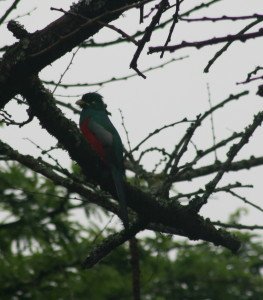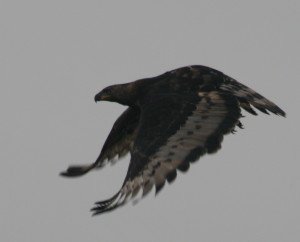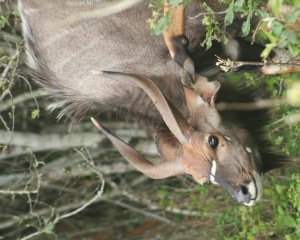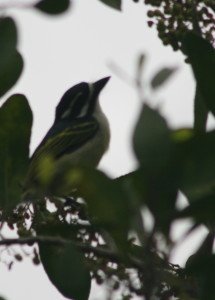Bonamanzi Game Park
As my birding colleagues will attest, I have a predilection for taking obscure tracks and paths in the bush – blame it on my sense of adventure coupled with acute FOMO* – but my detours have often thrown up remarkable sightings.
Any road without a clear No Entry or Private sign is fair game as far as I’m concerned and when I went off on what was an adventurous track in the central forests of Bonamanzi I was richly rewarded.
Soon I heard a loud, piercing call, so I got out of the car to investigate and there, sitting on an exposed branch, preening and calling away magnificently, was an Emerald Cuckoo.
It is a bird that I have long been searching for – the colour emerald also being one of my favourite things – and because it tends to keep to the top of the canopy, it is unobtrusive and hard to spot, except when calling. So it was my lucky day in terms of getting a long-sought-after lifer and a superb sighting of a dazzling bird.
Yellowspotted Nicator was calling further down the same little road and was kind enough to keep calling so I could also track it down on foot and the other Bonamanzi specials seen – Lemonbreasted Canary, Narina Trogon and Gorgeous Bush Shrike – were all also surprisingly obliging and easy to tick off.
The Lemonbreasted Canaries, also unobtrusive birds that were only discovered in 1960, are actually best seen on the road to Hluhluwe along the western border of Bonamanzi, where I spotted them once again on the side of the road.
Gorgeous Bush Shrike was calling loudly and comfortably sighted in the bushes on the side of the road leading out of the main camp, but Narina Trogon was amongst a host of delights that came to visit me at my campsite near the swimming pool.
The procession of lovely creatures viewed from my throne (what I call my fancy campchair) started on the first night as a pair of Thicktailed Bushbabies and a Rustyspotted Genet came to visit, followed the next day by Impala, Vervet Monkey, Emeraldspotted Wood Dove, Forest Weaver, Purplebanded Sunbird, Bearded Robin and Terrestrial Bulbul.
The day after brought a pair of Narina Trogons, then another, and altogether four pairs of this sought-after forest gem visited my camp on a single day!
The late afternoon brought a carnival of birds to the campsite thanks to a swarm of mayflies that were fluttering all over as a gentle rain fell. Southern Black Tit, Yellowbellied and Blackeyed Bulbul, Forest Weaver, Plumcoloured Starling, Yellowthroated Sparrow, Yellowbreasted and Rudd’s Apalis, the Narina Trogons and Collared Sunbird were all tucking in and then an Orangebreasted Bush Shrike took to flight and joined the feast.
For those who enjoy working hard for their sightings, there are plenty of skulkers at Bonamanzi, including the usual suspects – Greenbacked Camaroptera and Redchested Cuckoo.
When I eventually spotted the Bleating Warbler it was close to a Black Cuckoo and bouncing around like a cross between a wind-up toy and a jack-in-the-box!
The Piet-my-Vrou was calling insistently in camp but was equally determined not to be seen, until my patience won the day.
The main camp at Bonamanzi – Lalapanzi – is situated in sand forest around a dam and water hole, so there is plenty to see around the chalets.
Sombre Bulbuls call from the tops of the tall trees that are all around the fancy accommodation, Hadeda Ibis congregate around the big bird baths that are spread around the lawns, and walking down to the smaller pan in front of the offices is always worthwhile. On this occasion, half-a-dozen Water Dikkop were resting and hiding in the long grass, while the Fever Trees were a hive of activity, which was unsurprising because five different species of weaver were nesting there during this early summer visit.
The Yellow Weavers were the most prolific nesters, bundles of frantic activity, but there were also Thickbilled, Southern Masked, Spottedbacked and Lesser Masked Weaver nesting.
![IMG_1930[1]](http://kenborland.com/wp-content/uploads/2017/05/IMG_19301-e1494848468158-1024x587.jpg)
Spottedbacked Weavers fluttering in display below their nests
A Malachite Kingfisher was high atop one of the Fever Trees at the second, larger dam, while a juvenile Little Bittern skulked in the papyrus reeds and had me thinking of great rarities.
The southern part of Bonamanzi has a wilderness feel to it with no accommodation, only a few tracks and hiking trails, and often throws up something interesting.
Woollynecked Stork are found in the forest and a Crowned Eagle was sitting on a telephone pole at the southern boundary. Three black Impala were on the adjoining property, as was an Ostrich. Redbilled Oxpecker were with Giraffe and Impala near the Ndulalamithi Dam.
There is a lovely walking trail from the main camp leading 2km to a couple of hides overlooking pans. At the Leguaan pan, a Crested Guineafowl kept collecting items of food and bringing it back to its partner to eat, while a Water Dikkop was dipping itself in the water and flapping its wings in what looked like some sort of display.
The road to Hluhluwe along the western boundary also provides good birding and, apart from the Lemonbreasted Canaries, a Tambourine Dove disappeared quickly into the very thick undergrowth of the Mzineni River, with Redbilled Firefinch and Pintailed Whydah also in the vicinity of this river which flows into the northern tip of False Bay.
Telephone lines along the road are always worth examining and even some of the Rattling Cisticolas have taken to perching on them rather than the thorn bushes below, along with other typical bushveld birds such as European Bee-Eater, European Swallow, Blackeyed Bulbul, Glossy Starling and Yellowfronted Canary.
Sightings list
Nyala
Rustyspotted Genet
Thicktailed Bushbaby
Impala
Vervet Monkey
Crowned Hornbill
Blackbellied Starling
Forktailed Drongo
Blackbacked Puffback
Southern Black Tit
Yellowbellied Bulbul
Red Duiker
Natal Robin
Brownhooded Kingfisher
Emerald Cuckoo
Plains Zebra
Yellowspotted Nicator
Whitebrowed Scrub Robin
Sombre Bulbul
Blackwinged Stilt
Water Dikkop
Wood Sandpiper
Yellow Weaver
Nile Crocodile
Thickbilled Weaver
Southern Masked Weaver
Lesser Striped Swallow
European Bee-Eater
Lemonbreasted Canary
European Swallow
Blackeyed Bulbul
Glossy Starling
Yellowfronted Canary
Rattling Cisticola
Tambourine Dove
Redbilled Firefinch
Pintailed Whydah
Woollynecked Stork
Emeraldspotted Wood Dove
Forest Weaver
Purplebanded Sunbird
Bearded Robin
Terrestrial Bulbul
Black Cuckoo
Greenbacked Camaroptera
Hadeda Ibis
Purplecrested Lourie
Plumcoloured Starling
Acacia Rat
Yellowthroated Sparrow
Yellowbilled Kite
Yellowbreasted Apalis
Narina Trogon
Cape White-Eye
Collared Sunbird
Redchested Cuckoo
Black Crake
Spottedbacked Weaver
African Pied Wagtail
Lesser Masked Weaver
Striped Skink
Egyptian Goose
African Jacana
Diederick Cuckoo
Goldenrumped Tinker Barbet
Sacred Ibis
Grey Heron
Wiretailed Swallow
Warthog
Malachite Kingfisher
Little Bittern
Spurwinged Goose
Common Sandpiper
Rudd’s Apalis
African Fish Eagle
Dusky Flycatcher
Chinspot Batis
Blue Wildebeest
Crested Guineafowl
White-Eared Barbet
Leopard Tortoise
Paradise Flycatcher
Orangebreasted Bush Shrike
Red Bush Squirrel
Squaretailed Drongo
Crowned Eagle
Ostrich
Little Bee-Eater
Redeyed Dove
Gorgeous Bush Shrike
Southern Boubou
Giraffe
Redbilled Oxpecker
*FOMO = Fear of missing out




